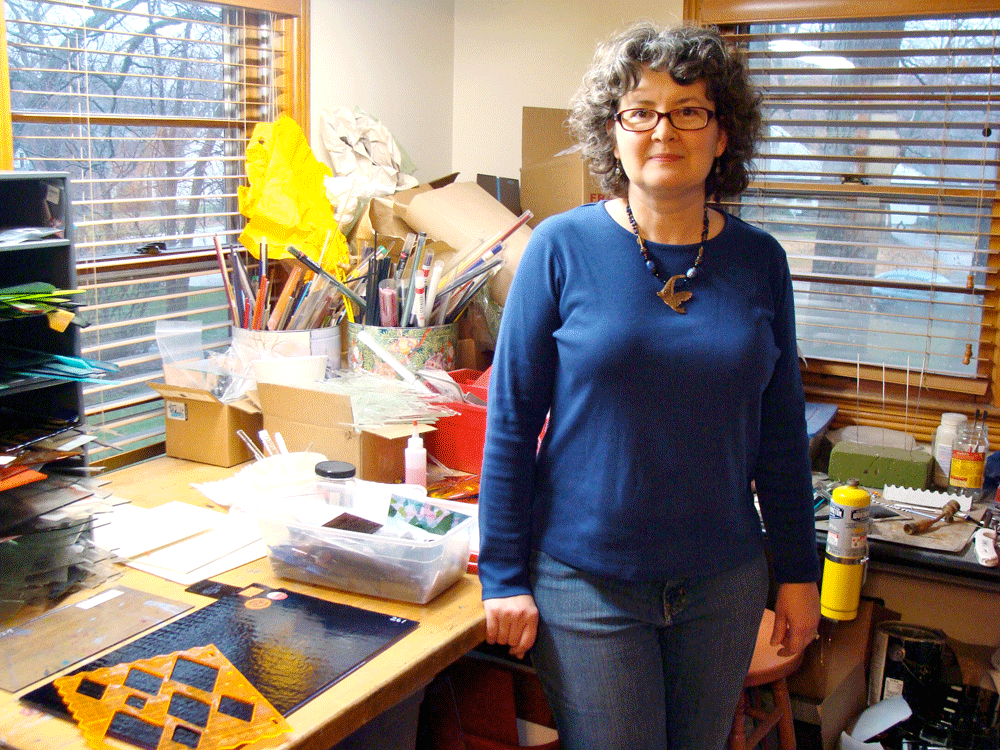Is there anything prettier than colored glass? It is perhaps the one man-made material that rivals the luminescent beauty of flowers. In flower petals, water inside the cell matter captures light waves and causes the blossoms to virtually glow with color. Glass similarly refracts light and comes in all colors of the rainbow. Like a child’s dazzling kaleidoscope, the brilliant colors and sparkle of glass are hard to resist. Dangerous to handle, unpredictably fragile, yet surprisingly tough in other applications, glass also seems to adhere to its own laws of physics. Did you know that, due to surface tension, all molten glass seeks to level itself at 1/4-inch thickness? That glass comes in different coefficients of expansion, or COE ratings? That just a score line and a snap is all it takes to cut shapes? That these shapes can be layered and fused together at 1,200-1,400 degrees into beautiful, durable patterns?
The practice of fusing glass has been around for centuries but has seen a steady gain in popularity as a cottage art form over the past 20 or so years. Small, affordable, stand-alone kilns have contributed to the rise. So has the marketing of craft kits for the beginning glass hobbyist. The kits supply everything one would need to get started, including a range of colored glass pieces having the same COE rating for foolproof success. And success, as they say, is addictive.
It was the gift of a hobby glass kit in 2002 that launched the career of Fort Wayne glass artist, Kathy Watson.
“For Christmas my sister gave me a craft kit for making lampwork beads, and that’s how I got started,” she says. Lampwork is done by manipulating thin glass rods in front of a torch, melting and twisting colors together, usually with the goal of making attractive beads for jewelry.
In a natural progression for jewelry making, Watson’s next step was to move on to fusing glass for pendants. The process involves layering a pattern of thin shards of colored glass onto a thicker backing piece. Then into the kiln it goes. The goal is to melt all layers into one piece and then anneal the glass with a prolonged and gradual cool-down. Anyone who has ever accidentally cracked a chilled drinking glass by immersing it in hot dish water knows the importance of annealing: it actually makes the glass stronger.
Watson grew up in Michigan and attended St. Claire County Community College where she had a few art classes, but none she found tempting enough to sway her from a career path as a dietician. She did dabble in quilt making for a while, and you can still see an affinity for geometric motifs in her glass designs.
“It’s like I’m still making quilts, only in glass,” she says.
Abundant circles and curves are featured in her designs, and it is hard to imagine making such perfect cuts over and over. Practice makes perfect, it seems, and she is quick to agree that the longer she’s been at it, the less glass is wasted.
And, one is almost afraid to ask, has she ever cut herself?
“Oh yes,” says she, exhibiting two finger lacerations about the size of paper cuts, “but I do have gloves that I can wear,” and points to a pair of sturdy work gloves.
Over time Watson has moved on to larger pieces which include glass tiles, plates and bowls. A flat piece of fused glass gets shaped into a bowl or dish by slumping it over a mold during a second firing in the kiln. Some of these vessels are meant to be functional. But most are intended to have their pretty colors displayed on custom stands that let ambient light shine through the layers. In this way they take on a life of their own, changing with the march of the sun or with a flick of a light switch. Even on the most gloomy of days the glass is radiant.
A recent commission that Watson has been working on is a series of five gayly colored glass discs that will hang at Parkview Hospital’s new Dupont location. The discs are 10 and 15 inches in diameter with floral motifs depicted in simple saturated colors.They would strike a note of cheer in any hospital corridor.
Watson has shown her work locally and regionally in Michigan and Wisconsin and has already won awards in juried shows. Sales of her work have steadily mounted year after year since her first exhibit in 2003, an impressive feat for an artist during recent recession years.
Watson currently teaches lampworking classes at GlassLink, an interactive glass studio and shop in Fort Wayne. She also maintains a virtual gallery on the Internet that will turn up in a search for Katharos Glass, the brand name of her line of art glass and jewelry. Her work regularly shows up in Fort Wayne events such as the Covington Art Fair, the Fort Wayne Museum of Art’s Art 4 Sale and, more recently, on the city’s Holly Trolley tour.



